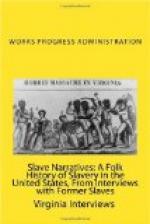Ex-Slave #18
INTERVIEW WITH (MRS.) MARIAH CALLAWAY EX-SLAVE
[TR: A significant portion of this interview was repeated in typescript; where there was a discrepancy, the clearer version was used. Where a completely different word was substituted, ‘the original’ refers to the typewritten page.]
Mrs. Mariah Callaway sat in a chair opposite the writer and told her freely of the incidents of slavery as she remembered them. To a casual observer it will come as a surprise to know the woman was blind. She is quite old, but her thoughts were clearly and intelligently related to the writer.
Mrs. Callaway was born in Washington, Wilkes County, Georgia probably during the year 1852, as she estimated her age to be around 12 or 13 years when freedom was declared. She does not remember her mother and father, as her mother died the second day after she was born, so the job of rearing her and a small brother fell on her grandmother, Mariah Willis, for whom she was named. Mrs. Callaway stated that the old master, Jim Willis, kept every Negro’s age in a Bible: but after he died the Bible was placed upstairs in the gallery and most of the pages were destroyed. The following is a story of the purchase of Mrs. Callaway’s grandfather as related by her.
“My grandfather come directly from Africa and I never shall forget the story he told us of how he and other natives were fooled on board a ship by the white slave traders using red handkerchiefs as enticement. When they reached America, droves of them were put on the block and sold to people all over the United States.
The master and mistress of their plantation were Mr. Jim Willis and Mrs. Nancy Willis who owned hundreds of acres of land and a large number of slaves. Mrs. Callaway was unable to give an exact number but stated the Willises were considered wealthy people. On their plantation were raised sheep, goats, mules, horses, cows, etc. Cotton, corn and vegetables were also raised. The Willis family was a large one consisting of six children. 4 boys and 2 girls. Their home was a large two-story frame house which was set apart from the slave quarters.
Slave homes on the Willis plantation differed in no respect from the usual type found elsewhere. All homes were simple log cabins grouped together, forming what is known as slave quarters.
The Willis family as kind and religious and saw to it that their slaves were given plenty of food to eat. Every Monday night each family was given its share of food for the week. Each grown person was given a peck of corn [TR: meal on original page] and three pounds of meat; besides the vegetables, etc. On Tuesday morning each family was given an ample amount of real flour for biscuits.




